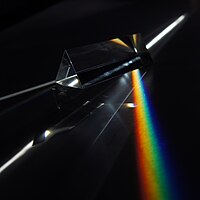
Photo from wikipedia
The theory of Hawking radiation can be tested in laboratory analogues of black holes. We use light pulses in nonlinear fiber optics to establish artificial event horizons. Each pulse generates… Click to show full abstract
The theory of Hawking radiation can be tested in laboratory analogues of black holes. We use light pulses in nonlinear fiber optics to establish artificial event horizons. Each pulse generates a moving perturbation of the refractive index via the Kerr effect. Probe light perceives this as an event horizon when its group velocity, slowed down by the perturbation, matches the speed of the pulse. We have observed in our experiment that the probe stimulates Hawking radiation, which occurs in a regime of extreme nonlinear fiber optics where positive and negative frequencies mix.
Journal Title: Physical review letters
Year Published: 2019
Link to full text (if available)
Share on Social Media: Sign Up to like & get
recommendations!